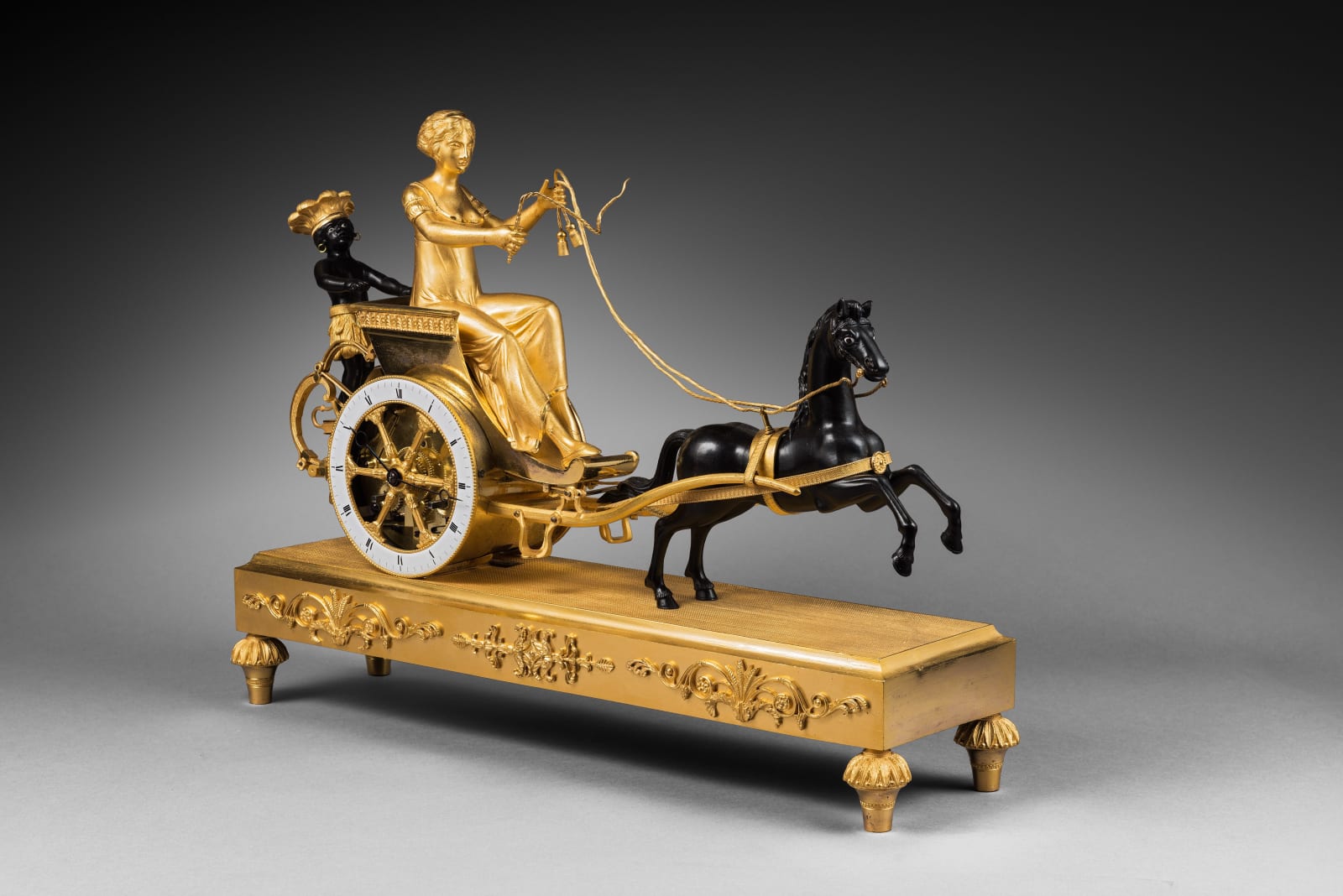Jean-Simon Deverberie (attributed to) 1864-1824
Literature
Yves Gay et André Lemaire, « Les pendules au char », in Bulletin de l'Association nationale des collectionneurs et amateurs d'horlogerie ancienne, printemps 1993, n°66, p.29.
A rare gilt and patinated chariot clock, attributed to Jean-Simon Deverberie (1764-1824)
The ring enamelled dial, shows the hours in Roman numerals and graduations minutes by two blued steel hands; it is part of the wheel of a car light buggy type that reveals the skeleton type of movement and in which sat a young woman in bronze finely carved and gilded, dressed in the fashion of the time and the hair up in a bun , holding a whip in one hand and reins in the other hand attached to the bite of a spirited horse, harnessed securely, patinated bronze "in the ancient." At the back of the female figure, perched on the tailboard, stands a young black boy, wearing a feather plume, glazed eyes and wearing a loincloth, which brings an exotic touch or tropical, the composition. It rests on a small cove gilt bronze rectangular base decorated with stylized motifs in bas-relief decorated with foliage, scrolls and palmettes, and underlined four feet of foliate friezes.
Paris, date circa 1795-1800.
Hauteur 34 cm ; largeur 45cm ; profondeur 12cm
At the end of the eighteenth century, under the impulse of the philosophical writings of Jean-Jacques Rousseau, who extolled the moral virtues of the return to nature through the myth of the "noble savage", the craze for the exotic was put special fashionable in contemporary literature. Thus, the prodigious literary success of "Paul et Virginie" of Bernardin de Saint-Pierre in 1788, a distant heir to the famous "Robinson Crusoe" by Daniel Defoe's novel "The Incas" Marmontel published during the war of independence American, as well as "Atala" Chateaubriand published in 1801, will profoundly upset the European approach to other civilizations and even to plunge culture of the old continent in a strong romantic nostalgia related to the pursuit of a pagan Eden regenerated by the Christianity. As often in the French decorative arts, this upheaval will have its manifestation in some artistic creations, mostly related to or watch luminaire. It is in this context that was created the pendulum that we present the model for which was developed by the bronze worker Jean-Simon Deverberie in the last years of the eighteenth century and has the particularity to make the connection between two types of clocks particularly prized by the great clock of the time lovers: the record called "the negro" and the record called "the tank."
Among the few listed similar models, most later include in particular: a first copy which is reproduced in Tardy, The French clock, Louis XVI From today, Paris, 1975, p.377; a second is exposed to François Duesberg museum in Mons (see Musée François Duesberg Decorative Arts 1775-1825, Brussels, 2004, p.54); Finally, a third cite particularly pendulum of this type that is part of the famous collection of the princes of Hesse in castle Fasanerie in Fulda (illustrated in the catalog of the exhibition Gehäuse der Zeit, 2002, p.93).
Deverberie Jean-Simon (1764-1824) is among the most important Parisian bronze workers of the late eighteenth century and the first two decades of the next century. Married to Marie-Louise Veron, it seems to be almost exclusively specializes in creating clocks, candlesticks and candelabra, filled with exotic figures, particularly African characters; he placed many clocks models say "the negro", including models called "Africa", "America" and "Indian and Indian entwined" (the drawings are kept at the Print Room at the National Library in Paris ). He set up his studio in 1800 successively Barbette Street, Temple Street in 1804, and finally Rue des Fosses du Temple between 1812 and 1820.



